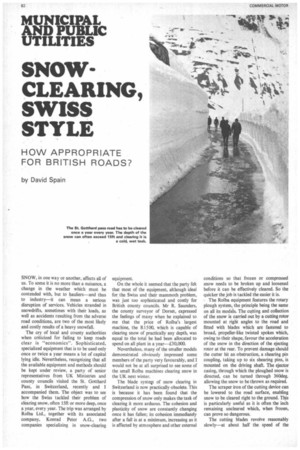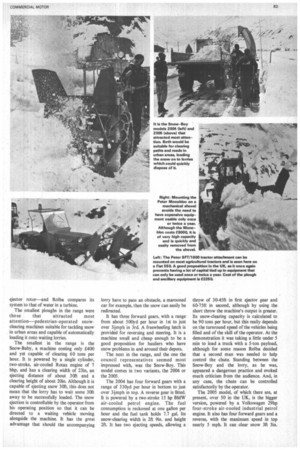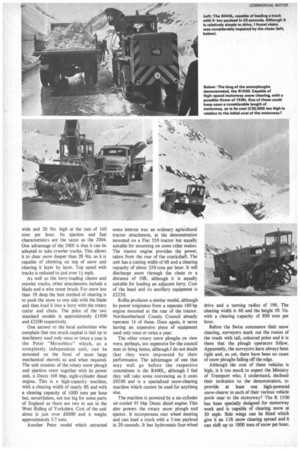MUNICIPAL AND PUBLIC UTILITIES
Page 84

Page 85

Page 86

If you've noticed an error in this article please click here to report it so we can fix it.
SNOW CLEARING, SWISS STYLE
HOW APPROPRIATE FOR BRITISH ROADS?
by David Spain
SNOW, in one way or another, affects all of us. To some it is no more than a nuisance, a change in the weather which must be contended with, but to hauliers—and thus to industry—it can mean a serious disruption of services. Vehicles stranded in snowdrifts, sometimes with their loads, as well as accidents resulting from the adverse road conditions, are two of the most likely and costly results of a heavy snowfall.
The cry of local and county authorities when criticized for failing to keep roads clear is "economics". Sophisticated, specialized equipment that is to be used only once or twice a year means a lot of capital lying idle. Nevertheless, recognizing that all the available equipment and methods should be kept under review, a party of senior representatives from UK Ministries and county councils visited the St, Gotthard Pass, in Switzerland, recently and I accompanied them. The object was to see how the Swiss tackled their problem of clearing snow, often 15ft or more deep, once a year, every year. The trip was arranged by Rolba Ltd., together with its associated company, Konrad Peter A.G., two companies specializing in snow-clearing
equipment.
On the whole it seemed that the party felt that most of the equipment, although ideal for the Swiss and their mammoth problem, was just too sophisticated and costly for British county councils. Mr R. Saunders, the county surveyor of Dorset, expressed the feelings of many when he explained to me that the price of Rolba's largest machine, the RI 500, which is capable of clearing snow of practically any depth, was equal to the total he had been allocated to spend on all plant in a year-00,000.
Nevertheless, many of the smaller models demonstrated obviously impressed some members of the party very favourably, and I would not be at all surprised to see some of the small Rolba machines clearing snow in the UK next winter.
The blade systecp of snow clearing in Switzerland is now practically obsolete. This is because it has been found that the compression of snow only makes the task of clearing it more arduous. The cohesion and plasticity of snow are constantly changing once it has fallen; its cohesion immediately after a fall is at a minimum, increasing as it is affected by atmosphere and other external conditions so that frozen or compressed snow needs to be broken up and loosened before it can be effectively cleared. So the quicker the job is tackled the easier it is.
The Rolba equipment features the rotary plough system, the principle being the same on all its models. The cu,tting and collection of the snow is carried out by a cutting rotor mounted at right angles to the road and fitted with blades which are fastened to broad, propeller-like twisted spokes which, owing to their shape, favour the acceleration of the snow in the direction of the ejecting rotor at the rear. To prevent damage should the cutter hit an obstruction, a shearing pin coupling, taking up to six shearing pins, is mounted on the driving shaft. The ejector casing, through which the ploughed snow is directed, can be turned through 360deg. allowing the snow to be thrown as required.
The scraper iron of the cutting device can be lowered to the road surface, enabling snow to be cleared right to the ground. This is particularly useful as it is often the inch remaining uncleared which, when frozen, can prove so dangerous.
The cutting blades revolve reasonably slowly—at about half the speed of the ejector rotor—and Rolba compares its system to that of water in a turbine.
The smallest ploughs in the range were those that attracted most attention--pedestrian-operated snowclearing machines suitable for tackling snow in urban areas and capable of automatically loading it onto waiting lorries.
The smallest in the range is the Snow-Baby, a machine costing only £400 and yet capable of clearing 60 tons per hour. It is powered by a single cylinder, two-stroke, air-cooled Rotax engine of 7 bhp, and has a clearing width of 23in, an ejecting distance of about 30ft and a clearing height of about 20in. Although it is capable of ejecting snow 30ft, this does not mean that the lorry has to wait some 30ft away to be successfully loaded. The snow ejection is controllable by the operator from his operating position so, that it can be directed to a waiting vehicle moving alongside the machine. It has the great advantage that should the accompanying lorry have to pass an obstacle, a marooned car for example, then the snow can easily be redirected.
It has three forward gears, with a range from about 500yd per hour in 1st to just over 3-i-mph in 3rd. A freewheeling latch is provided for reversing and steering. It is a machine small and cheap enough to be a good proposition for hauliers who have snow problems in and around their depots.
The next in the range, and the one the council representatives seemed most impressed with, was the Snow-Boy. This model comes in two variants, the 2004 or the 2005.
The 2004 has four forward gears with a range of 330yd per hour in bottom to just over 3+mph in top. A reverse gear is fitted. It is powered by a two-stroke 15 hp BMW air-cooled petrol engine. The fuel consumption is reckoned at one gallon per hour and the fuel tank holds 7.7 gal. Its snow-clearing width is 2ft 9in. and height 2ft. It has two ejecting speeds, allowing a throw of 30-45ft in first ejector gear and 60-75 ft in second, although by using the short throw the machine's output is greater. Its snow-clearing capacity is calculated to be 90 tons per hour, but this really depends on the turnround speed of the vehicles being filled and of the skill of the operator. At the demonstration it was taking a little under 5 min to load a truck with a 5-ton payload, although for some reason Rolba decided that a second man was needed to help control the chute. Standing between the Snow-Boy and the lorry, as he was, appeared a dangerous practice and evoked much criticism from the audience. And, in any case, the chute can be controlled satisfactorily by the operator.
The 2005 model, of which there are, at present, over 50 in the UK, is the bigger version, powered by a Volkswagen 29hp four-stroke air-cooled industrial petrol engine. It also has four forward gears and a reverse, with the maximum speed in top nearly 5 mph. It can clear snow 3ft 3hi.
wide and 2ft 9in. high at the rate of 160 tons per hour. Its ejection and fuel characteristics are the same as the 2004. One advantage of the 2005 is that it can be adapted to take crawler tracks. This allows it to clear snow deeper than 2ft 9in. as it is capable of climbing on top of snow and clearing it layer by layer. Top speed with tracks is reduced to just over 1-1mph.
As well as the lorry-loading chutes and crawler tracks, other attachments include a blade and a wire street brush. For snow less than 1ft deep the best method of clearing is to push the snow to one side with the blade and then load it into a lorry with the rotary cutter and chute. The price of the two standard models is approximately £1900 and £2200 respectively.
One answer to the local authorities who complain that too much capital is tied up in machinery used only once or twice a year is the Peter "MonobIoc" which, as a completely, independent unit, can be mounted on the front of most large mechanical shovels as and when required. The unit consists of the rotary snow plough and ejection rotor together with its power unit, a Deutz 168 bhp, eight-cylinder diesel engine. This is a high-capacity machine, with a clearing width of nearly 8ft and with a clearing capacity of 1000 tons per hour but, nevertheless, not too big for some parts of England as there are two in use in the West Riding of Yorkshire. Cost of the unit alone is just over /8000 and it weighs approximately 3.7 tons.
Another Peter model which attracted
some interest was an ordinary agricultural tractor attachment, at the demonstration mounted on a Fiat 550 tractor but equally suitable for mounting on some other makes. The tractor engine provides the power, taken from the rear of the crankshaft. The unit has a cutting width of 6f1 and a clearing capacity of about 250 tons per hour. It will discharge snow through the chute to a distance of 50ft, although it is equally suitable for loading an adjacent lorry. Cost of the head and its ancillary equipment is £2250.
Rolba produces a similar model, although its power originates from a separate 180 hp engine mounted at the rear of the tractor. Northumberland County Council already operates 16 of these. Once again, it saves having an expensive piece of equipment used only once or twice a year: The other rotary snow ploughs on view were, perhaps, too expensive for the council men to bring home, although I do not doubt that they were impressed by their performance. The advantages of one that may well go before the respective committees is the R400L, although I feel they will take some convincing as it costs £9500 and is a specialized snow-clearing machine which cannot be used for anything else.
The machine is powered by a six-cylinder air-cooled 95 bhp Deutz diesel engine. This also powers the rotary snow plough and ejector. It incorporates rear wheel steering and can load a truck with a 5-ton payload in 20 seconds. It has hydrostatic four-wheel drive and a turning radius of 1911. The clearing width is 6ft and the height Sft 7in. with a clearing capacity of 800 tons per hour.
Before the Swiss commence their snow clearing, surveyors mark out the routes of the roads with tall, coloured poles and it is these that the plough operators follow. Apparently, the surveyors have always been right and, as yet, there have been no cases of snow ploughs falling off the edge.
Although the cost of these vehicles is high, is it too much to expect the Ministry of Transport who, I understand, declined their invitation to the demonstration, to provide at least one high-powered snow-clearer in each of their various vehicle pools near to the motorway? The R 15 00 has been specially designed for motorway work and is capable of clearing snow at 30 mph. Side wings can be fitted which give it an 11ft snow clearing spread and it can shift up to 1800 tons of snow per hour.




























































































































































































